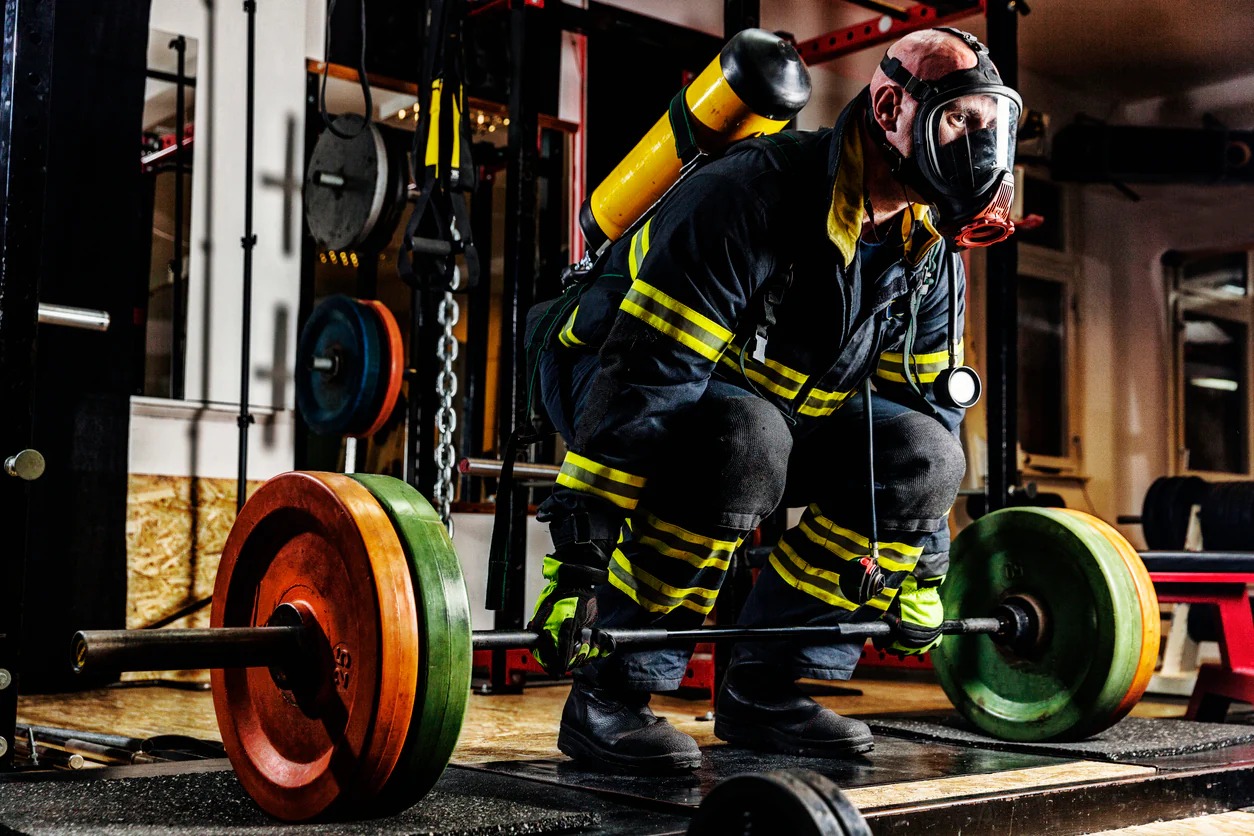
Firefighter Fitness – Training to Carry 50 Kg of Gear.
Firefighter fitness is a specialized, high-intensity training approach designed to prepare professionals to carry up to 50 kilograms of gear while performing life-saving tasks. It integrates functional strength, cardiovascular endurance, flexibility, core stability, mental resilience, nutrition, and recovery strategies, ensuring firefighters can operate safely, efficiently, and effectively in extreme, high-stress, and unpredictable emergency environments.
💪 Fitness Guru
54 min read · 7, Oct 2025

Introduction: The Weight of Duty
Firefighting is not merely a job—it’s a test of human endurance, strength, and mental resilience. Firefighters face life-threatening situations daily, often while carrying up to 50 kilograms (110 pounds) of gear, including protective clothing, breathing apparatus, hoses, and rescue tools. The ability to perform physically demanding tasks in high-stress, heat-intense environments requires specialized training beyond conventional fitness routines. This article explores the science, techniques, and principles behind firefighter fitness, focusing on how professionals train their bodies and minds to operate effectively while bearing the immense load of lifesaving equipment.
1. Understanding the Firefighter’s Load
The standard firefighting ensemble is a combination of protective gear and essential tools that together add up to a surprising weight.
Breakdown of typical firefighter equipment:
- Turnout Gear (Helmet, Jacket, Pants, Boots, Gloves): 20–25 kg
- Self-Contained Breathing Apparatus (SCBA): 15–18 kg
- Tools (Axe, Halligan Bar, Hose Nozzle, etc.): 10–15 kg
- Thermal Imaging Camera, Radios, and Personal Gear: 5–10 kg
Total: 45–55 kg (varies by department and mission type)
Firefighters must climb stairs, crawl through tight spaces, break down doors, and rescue victims while carrying this weight. The body’s ability to maintain balance, stamina, and mobility under such conditions is vital for survival and success. Therefore, their training must replicate these real-world demands through functional, tactical, and endurance-based programs.
2. Physiological Demands of Firefighting
When wearing 50 kg of gear, a firefighter’s oxygen consumption (VO₂) can reach levels equivalent to elite athletes. Heart rates often soar to 170–190 beats per minute, even before actual fire suppression begins. Add to that heat stress, dehydration, and cognitive fatigue, and the profession becomes a full-spectrum test of fitness.
Key physiological challenges include:
- Cardiovascular strain due to weight and heat exposure
- Muscle fatigue from carrying, dragging, or lifting loads
- Reduced mobility caused by heavy and restrictive gear
- Breathing difficulty under SCBA masks
- Thermal stress from high ambient and internal temperatures
Firefighter fitness training, therefore, focuses on functional strength, cardiovascular conditioning, flexibility, and mental toughness—all adapted to mimic real emergency conditions.
3. Core Elements of Firefighter Fitness Training
Firefighters train like tactical athletes—similar to military special forces or rescue divers—because their duties require explosive strength, sustained endurance, and precision under pressure.
A. Functional Strength Training
Functional strength training develops power for real-life movements such as climbing ladders, carrying victims, and dragging hoses.
Key exercises include:
- Deadlifts and Power Cleans: Build posterior chain strength for lifting heavy loads.
- Farmer’s Walks: Simulate carrying hoses or equipment.
- Sandbag Carries and Tire Drags: Mimic awkward, uneven weight handling.
- Stair Climbs with Weighted Vest: Build lower body power and cardiovascular endurance.
Firefighters typically train with weighted vests (20–30 kg) to gradually adapt their bodies to the demands of carrying 50 kg during operations.
B. Cardiovascular Conditioning
Firefighting requires both aerobic and anaerobic capacity. Training often alternates between high-intensity bursts (simulating emergency response) and steady-state cardio (representing sustained tasks).
Popular methods:
- High-Intensity Interval Training (HIIT) – improves oxygen efficiency.
- Sled pushes, rowing machines, and stair sprints – replicate physical tasks.
- Long-distance running, cycling, or swimming – enhance endurance.
The goal is to maintain performance even when the heart rate is near its maximum threshold.
C. Mobility and Flexibility
Heavy gear can restrict movement, so flexibility prevents injury and enhances performance.
Daily stretching routines focus on:
- Shoulders and back for hose handling
- Hips and hamstrings for crawling or kneeling
- Core rotation for tool use and victim carries
Yoga and dynamic stretching have become integral in many fire academies to improve range of motion and body control.
D. Core and Stability Training
The core acts as the foundation for all movements. Under 50 kg of gear, weak stability can lead to back injuries or poor posture.
Essential core drills:
- Planks and Side Planks
- Kettlebell Swings
- Medicine Ball Rotations
- Suspension (TRX) Core Workouts
A strong core also helps maintain breathing efficiency under the compression of protective suits.
E. Heat Acclimation and Hydration Training
Firefighters train under simulated heat conditions to adapt to high temperatures and dehydration risks.
Some departments use:
- Sauna or heat chamber sessions post-exercise.
- Sweat testing to measure hydration loss.
- Electrolyte balancing through nutritional monitoring.
This prepares them to operate efficiently even when core temperatures rise above safe thresholds.
4. Mental Conditioning and Stress Management
Physical fitness alone is not enough. Firefighters must stay calm, think critically, and make fast decisions in chaotic environments.
Key psychological training elements include:
- Breathing control techniques to manage stress under SCBA masks.
- Simulation drills with alarms, smoke, and heat to build resilience.
- Mindfulness and visualization to enhance focus and confidence.
- Team-based problem solving to reinforce communication and trust.
By simulating high-stress conditions during training, firefighters build mental endurance that translates directly to real-world emergency performance.
5. Nutrition for Tactical Athletes
Proper nutrition fuels performance and recovery. Firefighters burn an estimated 700–1000 calories per hour during active duty.
Recommended nutrition plan:
- Protein: 1.6–2.0 g per kg of body weight (for muscle repair).
- Carbohydrates: 45–60% of total calories (for energy).
- Healthy fats: Avocado, nuts, olive oil (for sustained energy).
- Hydration: At least 3–4 liters of water daily, with electrolyte replenishment.
Meal timing is also crucial—balanced meals before shifts and recovery snacks afterward maintain energy and focus.
6. Sample Weekly Firefighter Training Plan
Day Focus Example Workouts Monday Strength & Load Carrying Deadlifts, Sandbag Carries, Farmer’s Walks Tuesday Cardio Endurance Stair Sprints, Rowing, Interval Runs Wednesday Mobility & Recovery Yoga, Foam Rolling, Stretching Thursday Functional Power Tire Flips, Sledgehammer Hits, Sled Pushes Friday Core Stability Planks, TRX Rows, Medicine Ball Twists Saturday Simulation Drill Full Gear Stair Climb, Victim Drag Practice Sunday Rest & Recovery Light Walking, Hydration, Nutrition Focus This type of schedule balances intensity, recovery, and simulation of real-world demands.
7. The Role of Technology in Firefighter Fitness
Modern technology has entered firefighter fitness programs through wearable devices and virtual simulations:
- Heart rate monitors and oxygen sensors track exertion during drills.
- Virtual fire simulations train decision-making under pressure.
- AI-based fitness apps personalize training loads based on recovery and readiness scores.
Departments globally are investing in firefighter wellness initiatives, recognizing that long-term health reduces injuries and improves operational readiness.
8. Injury Prevention and Longevity
Injury rates among firefighters are high due to overexertion and repetitive strain. Preventive strategies include:
- Prehabilitation exercises to strengthen joints and ligaments.
- Active recovery sessions like swimming and mobility flow routines.
- Regular physical assessments to detect imbalances early.
Firefighter fitness is not just about peak performance but career longevity and safety.
9. Women in Firefighting: Breaking Physical Barriers
Female firefighters are proving that strength isn’t just about muscle mass but efficiency, technique, and endurance. Training programs are being adapted to include gender-specific biomechanics, focusing on:
- Optimizing strength-to-weight ratio
- Enhancing upper body endurance through resistance work
- Emphasizing core power and lifting form
This inclusive approach has made firefighting a more diverse and equitable profession.
10. Building a Culture of Fitness
Firefighter fitness isn’t limited to individual responsibility—it’s a department-wide culture. Many firehouses now include:
- On-site gyms and structured workout schedules.
- Peer fitness trainers to guide recruits.
- Annual fitness assessments with rewards for top performers.
- Mental health support programs to manage burnout.
This holistic ecosystem ensures that physical and psychological readiness becomes part of everyday life.
Firefighter fitness is an extraordinary and highly specialized realm of physical conditioning that goes far beyond the traditional concepts of gym workouts or general athletic training because it is designed to prepare individuals for one of the most physically and mentally demanding professions in the world, where every second counts and the stakes are nothing short of life and death; unlike typical fitness routines that may focus solely on aesthetic goals or performance metrics in controlled environments, firefighter fitness must simulate the unpredictable, high-intensity, and often chaotic conditions of real firefighting scenarios, where an individual may be required to carry, lift, drag, and maneuver with a total load of equipment that can exceed fifty kilograms, which includes a combination of turnout gear consisting of a helmet, flame-resistant jacket and pants, gloves, boots, and other protective items, a self-contained breathing apparatus that adds significant bulk and weight, hoses and nozzles that may vary in size and pressure, axes and halligan tools for forcible entry, radios, thermal imaging devices, medical kits, and personal items that are all essential for both safety and operational effectiveness, and to perform effectively under such burdens, firefighters must develop not only sheer muscular strength but also functional strength that translates directly into practical movement patterns such as lifting, pushing, pulling, carrying, dragging, and climbing while maintaining balance and coordination, because these tasks are frequently performed under extreme environmental stressors including high heat, smoke, poor visibility, slippery surfaces, unstable structures, and psychological stress from the knowledge that human lives may depend on their actions; as a result, firefighter fitness programs are carefully structured to address multiple domains of physical conditioning, including cardiovascular endurance to sustain prolonged activity while wearing heavy equipment, anaerobic power to manage sudden bursts of intense effort like breaking down doors or rescuing victims, muscular endurance to prevent fatigue during continuous operations, core stability to maintain posture and prevent injury under compressive forces, joint mobility and flexibility to allow for crawling through confined spaces and maneuvering around obstacles, grip strength to securely handle tools and hoses, and overall body coordination to seamlessly integrate these various abilities while executing complex emergency maneuvers; beyond the purely physical components, training also incorporates mental conditioning, because firefighting is a profession where the cognitive load is immense and decision-making must remain clear under life-threatening conditions, so firefighters practice stress inoculation through realistic simulations, controlled exposure to smoke and heat, time-sensitive rescue drills, and scenarios that challenge problem-solving, situational awareness, and teamwork, often under the watchful supervision of experienced instructors who provide immediate feedback and corrections to ensure both safety and skill acquisition; nutritional strategies are also a critical aspect of firefighter fitness because the combination of physical exertion and heat stress significantly increases caloric and fluid requirements, necessitating a diet rich in protein to support muscle repair, sufficient complex carbohydrates to fuel prolonged activity, healthy fats for sustained energy release, and electrolytes to maintain hydration and prevent cramping or heat-related illness, while meal timing and portion control are optimized to ensure that firefighters begin their shifts with adequate energy reserves and recover efficiently post-activity; modern firefighter fitness programs increasingly utilize technological innovations such as wearable devices to monitor heart rate, oxygen saturation, and movement patterns, virtual reality and augmented reality simulations to replicate complex emergency scenarios without physical risk, and data-driven performance analytics to track progress, identify weaknesses, and customize training loads, all of which contribute to improved preparedness and reduced injury risk, which is particularly important given that firefighting is among the professions with the highest rates of musculoskeletal injuries due to repetitive lifting, awkward postures, sudden exertions, and prolonged standing or crawling in heavy gear; functional strength training is central to preparing the body for the specific demands of carrying fifty kilograms of equipment, and exercises such as deadlifts, squats, power cleans, overhead presses, kettlebell swings, sled pushes, tire flips, and sandbag carries are carefully integrated into weekly routines to develop muscle groups in ways that directly mirror operational tasks, while cardiovascular conditioning involves a blend of steady-state aerobic work, high-intensity interval training, stair climbs with weighted vests, and simulated hose drags to enhance both oxygen utilization and recovery rates; flexibility and mobility work, often incorporating yoga, dynamic stretches, and joint-specific exercises, ensures that the body maintains a full range of motion despite the restrictive nature of protective clothing and allows for safer movement during crawling, climbing, or bending, whereas core and stability training strengthens the muscles of the trunk to support lifting, carrying, and sudden directional changes under load, preventing injury and improving overall efficiency; mental toughness and stress resilience are cultivated through repeated exposure to simulated high-pressure environments that mimic smoke-filled buildings, heat, alarms, and time constraints, teaching firefighters to regulate breathing, maintain focus, and execute complex tasks while fatigued and under psychological strain; additionally, departments recognize that fostering a culture of fitness is essential for long-term operational effectiveness, so many firehouses provide on-site gyms, structured workout schedules, peer mentorship programs, annual physical assessments, and wellness initiatives that encompass both physical and mental health, including recovery protocols, sleep hygiene education, and support for managing occupational stress and trauma; for female firefighters, programs are adapted to optimize strength-to-weight ratios and emphasize technique, core power, and endurance, ensuring that all personnel, regardless of gender, can meet the rigorous demands of the job without compromising safety or effectiveness, while continuing advancements in gear design and ergonomics, informed by research in human biomechanics and occupational health, further support the integration of fitness and operational readiness by reducing unnecessary strain and allowing for better movement efficiency; ultimately, firefighter fitness is a holistic system of preparation that merges strength, endurance, flexibility, mental resilience, nutrition, and technology to create highly capable individuals who can operate effectively under extreme conditions, carry heavy loads of gear, save lives, and maintain long-term health and performance in one of the most physically and psychologically demanding professions in the world.
Firefighter fitness represents one of the most demanding and specialized forms of physical conditioning, designed not merely to improve general strength or endurance but to prepare individuals for the extraordinary challenges of a profession that requires them to carry up to fifty kilograms of gear while performing life-saving tasks in extreme, unpredictable, and often dangerous environments, where the combination of heavy protective clothing, breathing apparatus, tools, hoses, communication devices, and personal equipment creates a physical load that surpasses typical athletic training, and where every movement, from climbing stairs, crawling through confined spaces, lifting and dragging victims, breaking down doors, and maneuvering hoses, must be executed efficiently and safely despite the added weight, restricted mobility, and the presence of heat, smoke, unstable structures, and psychological stress; to meet these demands, firefighter training programs are designed with a multi-dimensional approach that integrates functional strength exercises, cardiovascular conditioning, flexibility and mobility work, core stability training, mental resilience development, nutrition strategies, and recovery protocols, all tailored to replicate real-life scenarios as closely as possible, and functional strength training focuses on movements that mirror actual tasks, such as deadlifts and power cleans to develop posterior chain strength, squats and lunges for lower body power, overhead presses and rows for upper body pushing and pulling, farmer’s walks and sandbag carries for grip strength and load handling, and tire flips or sled pushes to simulate awkward and dynamic weight, while cardiovascular conditioning is critical to sustain both aerobic and anaerobic capacity during prolonged or intense firefighting operations, incorporating high-intensity interval training, stair climbing with weighted vests, treadmill sprints, rowing, cycling, and simulated hose drags to improve oxygen utilization, recovery rates, and endurance under load, and flexibility and mobility work ensures that the body maintains range of motion despite the restrictive nature of protective gear, using dynamic stretching, yoga, joint-specific exercises, and foam rolling to prevent injuries during crawling, bending, and twisting motions, whereas core and stability training strengthens the trunk muscles, which are essential for posture, balance, lifting, and carrying heavy equipment safely, using planks, side planks, medicine ball rotations, TRX exercises, and rotational movements to build a stable foundation for all physical activity; mental conditioning is equally vital, as firefighters must make rapid decisions under extreme stress, often in smoke-filled, high-heat, or chaotic environments, and training includes simulated emergency drills, stress inoculation exercises, breathing techniques, mindfulness practices, teamwork challenges, and scenario-based problem-solving to enhance focus, situational awareness, and cognitive resilience, while nutrition strategies support the immense energy demands of the job, providing sufficient protein for muscle repair, complex carbohydrates for sustained energy, healthy fats for endurance, and electrolytes for hydration balance, along with carefully timed meals and snacks to optimize performance and recovery, and modern firefighter programs increasingly leverage technology such as wearable heart rate and oxygen monitors, virtual reality simulations, and AI-based fitness tracking to provide real-time feedback, monitor exertion, prevent overtraining, and ensure that trainees develop the appropriate strength, endurance, and resilience required for operational readiness; preventive measures are emphasized to reduce injuries, including prehabilitation exercises, proper lifting techniques, joint stabilization, active recovery, and regular physical assessments, as the combination of heavy gear, repetitive strain, awkward postures, and sudden exertion poses significant musculoskeletal risks, while departmental culture fosters ongoing fitness by providing on-site gyms, structured workout schedules, peer mentorship, fitness challenges, and wellness initiatives that integrate both physical and mental health support, ensuring that personnel remain capable of performing under extreme conditions, and for female firefighters, training programs are adapted to optimize strength-to-weight ratios, emphasize core and functional strength, and account for gender-specific biomechanics, allowing all firefighters to meet rigorous operational standards effectively; firefighter fitness is thus a comprehensive system that blends physical conditioning, mental resilience, nutrition, recovery, technological monitoring, and a supportive culture to prepare individuals for the extraordinary demands of carrying fifty kilograms of gear while performing complex, high-risk operations, making it a profession where physical capability, mental toughness, and sustained endurance intersect in the most critical of ways, demonstrating that true firefighter readiness is not simply about lifting heavy weights or running long distances, but about developing an integrated set of abilities that allow a person to operate efficiently, safely, and effectively in life-or-death situations, where every movement and decision can have profound consequences, and where the combination of strength, stamina, agility, flexibility, cognitive function, teamwork, and adaptability ultimately defines the ability to save lives and protect communities under the most extreme conditions imaginable, ensuring that firefighters remain not only physically prepared but mentally alert, nutritionally supported, and operationally capable throughout their careers, which underscores the importance of a holistic, multi-disciplinary approach to training that integrates real-world task simulation, progressive overload, recovery strategies, injury prevention, psychological resilience, and technological innovation to create elite tactical athletes who can endure, perform, and excel under the extraordinary physical, mental, and environmental demands of firefighting, making firefighter fitness a unique and vital field of study and practice in the broader context of occupational health, human performance, and emergency services, where the weight of the gear symbolizes the weight of responsibility, and where preparedness, strength, endurance, and resilience are the ultimate tools for survival and effectiveness in the line of duty.
Conclusion
Firefighting is among the world’s most physically demanding professions. Carrying 50 kilograms of gear while saving lives requires elite-level fitness, endurance, and mental toughness. Through a combination of functional training, cardiovascular conditioning, flexibility, and psychological resilience, firefighters prepare their bodies to handle extreme physical and emotional demands.
Training must mirror real-life challenges—climbing stairs with weight, dragging hoses, and enduring heat stress. Proper nutrition, hydration, recovery, and mental conditioning complete the equation.
In essence, firefighter fitness is a lifelong commitment to operational excellence and survival. It transforms ordinary individuals into tactical athletes capable of extraordinary feats under the harshest conditions.
Q&A Section
Q1: Why do firefighters carry up to 50 kg of gear?
Ans: Because firefighting requires protective equipment, breathing apparatus, and heavy tools to ensure safety and effectiveness during rescue and suppression operations.
Q2: What type of training helps firefighters manage such heavy loads?
Ans: Functional strength training, high-intensity interval workouts, stair climbs, and simulation drills help firefighters adapt to the weight and improve endurance.
Q3: How does heat affect firefighter performance?
Ans: High heat increases heart rate, causes dehydration, and leads to faster fatigue. Firefighters train in simulated heat environments to build heat tolerance.
Q4: What is the role of nutrition in firefighter fitness?
Ans: Balanced nutrition with adequate proteins, carbohydrates, and hydration supports energy, muscle recovery, and long-term stamina.
Q5: Can women meet the same physical standards as men in firefighting?
Ans: Yes. With targeted strength and endurance training focusing on biomechanics and efficiency, women firefighters perform equally well under demanding conditions.
Similar Articles
Find more relatable content in similar Articles

How Nutrition Impacts Hair and Nail Health..
Healthy hair and nails reflec.. Read More

Natural Hair Care Tips for Healthy Growth..
Natural hair care focuses on .. Read More

Firefighter Fitness – Training to Carry 50 Kg of Gear...
Firefighter fitness is a speci.. Read More

Fitness Meets Fashion – Wearable Gear That Looks Like Street..
Wearable gear is transforming .. Read More
© 2024 Copyrights by rFitness. All Rights Reserved.